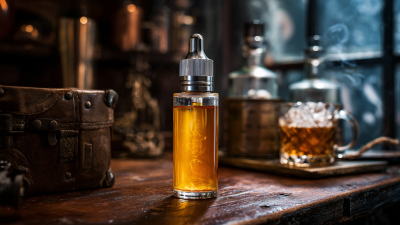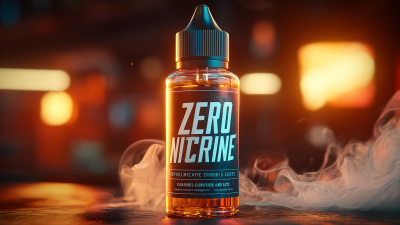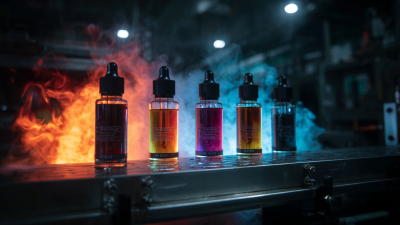The rise of Tobacco E Liquid has revolutionized the smoking landscape, transitioning users from traditional combustible cigarettes to modern vaping solutions. According to a report by Grand View Research, the global e-cigarette market, which encompasses Tobacco E Liquid, was valued at approximately USD 18.13 billion in 2022 and is projected to expand at a compound annual growth rate (CAGR) of 27.3% from 2023 to 2030. This shift reflects a growing consumer preference for alternatives perceived as less harmful, as the American Lung Association notes that vaping delivers nicotine without the harmful tar and chemicals found in traditional tobacco products. Furthermore, a survey by the National Institute on Drug Abuse (NIDA) indicates that more than 20% of high school students in the U.S. reported using e-cigarettes, underscoring the widespread adoption of Tobacco E Liquid among younger demographics. This introduction explores the evolution of Tobacco E Liquid, examining its impact on public health, social perceptions, and market dynamics.

The shift from traditional tobacco products to vaping solutions reflects a significant evolution in consumer preferences and health awareness. Unlike conventional cigarettes, which combust tobacco to release harmful chemicals and tar, e-liquids used in vaping devices deliver nicotine in a vaporized form, often accompanied by various flavors. This modern approach has captivated a growing number of smokers looking for alternatives that are perceived to be less harmful and more customizable in terms of flavor and nicotine strength.
Furthermore, the social perception surrounding smoking has changed dramatically with the rise of vaping. Vaping is often viewed as a trendy and more socially acceptable activity, particularly among younger demographics. The marketing strategies employed by e-liquid manufacturers emphasize lifestyle and technological innovation, resonating with consumers who value both health and aesthetics. As research continues to explore the long-term effects of vaping, the allure of e-liquids remains strong, steering many away from traditional smoking and marking a new chapter in the narrative of tobacco consumption.
| Year | Traditional Tobacco Use (Million Users) | Vaping Use (Million Users) | E-Liquid Flavors Available | Health Awareness (% of Users) |
|---|---|---|---|---|
| 2010 | 1,200 | 5 | 15 | 30% |
| 2012 | 1,100 | 30 | 30 | 35% |
| 2014 | 950 | 70 | 50 | 45% |
| 2016 | 800 | 150 | 90 | 55% |
| 2018 | 600 | 250 | 120 | 65% |
| 2020 | 400 | 310 | 150 | 70% |
The rise of e-liquids marks a significant shift in the smoking landscape, particularly as vaping becomes increasingly popular among young adults and teens. Modern e-liquids primarily consist of a base of propylene glycol and vegetable glycerin, enhanced with nicotine, flavorings, and various additives. This blend appeals to many, particularly Gen Z, as it offers a range of flavors and perceived decreased health risks compared to traditional cigarettes. Despite this perception, recent studies reveal alarming findings regarding the potential harm of vaping, highlighting the presence of toxic metals like lead and nickel in some disposable devices.
As vaping eclipses traditional smoking in popularity, particularly in places like Britain, concerns regarding health risks and regulations have intensified. While e-cigarettes are banned in countries like India, the allure of flavored e-liquids keeps the demand alive, despite the known hazards. Ongoing research underscores the necessity for consumers to remain informed about the ingredients in their e-liquids, as well as the implications of these substances on their health. The evolution of nicotine consumption methods continues to evolve, merging trends of convenience and enjoyment with pressing health concerns.
The vaping industry is rapidly evolving, particularly in the realm of e-liquids, where flavor profiles are becoming a paramount feature of user experience. Recent reports indicate that the e-cigarette market is diversifying its offerings by incorporating a wide range of flavors, catering to various consumer preferences. For instance, the latest introduction of flavor-adjustable vapes allows users to tailor their experience, merging two unique flavors into a single session. This focus on customization not only enhances the enjoyment but also attracts new users who seek a more personalized vaping experience.
With consumer preferences shifting towards distinct and diverse flavors, industry analysis shows a significant rise in demand for unique vape juice formulations. Reports highlight that the market is projected to continue expanding, specifically in the disposable vape segment, which offers convenience alongside an abundant selection of flavors. This trend underscores the importance of flavor innovation as a driving force behind the evolution of vaping products.
Tip: For a truly enjoyable vaping experience, experiment with different flavor combinations. Mixing complementary flavors can lead to exciting new tastes.
Tip: Always check reviews and industry reports to find e-juices that not only tantalize your taste buds but also meet quality and safety standards, ensuring a satisfying and secure vaping experience.
The e-liquid industry has witnessed substantial evolution over the years, particularly as safety and regulatory standards have become more pronounced. Recent measures, such as the implementation of a new mandatory safety standard for lithium batteries used in energy storage systems in China, highlight the growing emphasis on safety across various sectors. This standard, GB 44240-2024, marks a significant step as the first compulsory national standard for battery safety in the country, underlining the need for rigorous compliance frameworks that can extend to the e-liquid market as it matures.
Moreover, the emergence of regulations aligned with the European Tobacco Products Directive (EUTPD) has pressured manufacturers to adopt safer practices and improve product quality. With the Chinese market being one of the largest for vaping products, the need for compliance with international standards has become pivotal. As per industry reports, the integration of enhanced safety protocols not only protects consumers but also fosters growth in a sector that has faced scrutiny due to inconsistent product quality. As the landscape of vaping continues to shift, stakeholders must remain vigilant to ensure that regulations are effectively navigated, ultimately promoting a safer and more reliable industry.
The vaping landscape is rapidly evolving, with innovations and trends reshaping the future of tobacco alternatives. The nicotine pouch market is experiencing significant growth, projected to increase from $5 billion in 2022 to $13.5 billion by 2030, driven by a compound annual growth rate of 12.8% from 2024 to 2030. This surge reflects a growing preference among consumers for smokeless and convenient alternatives to traditional smoking, indicating a clear shift in market dynamics.
At the forefront of this evolution are advancements showcased at recent expos, where major players have introduced a range of new products aligning with current trends. The vaping market itself, valued at $20 billion in 2022, is expected to reach $45 billion by 2030, with a compound annual growth rate of 10% during the same period. As the industry continues to innovate, factors such as improved product design, flavor diversity, and health awareness are driving consumer interest and expanding the appeal of vaping as a tobacco alternative. This environment promises a vibrant future as brands strive to meet the evolving demands of health-conscious consumers.






